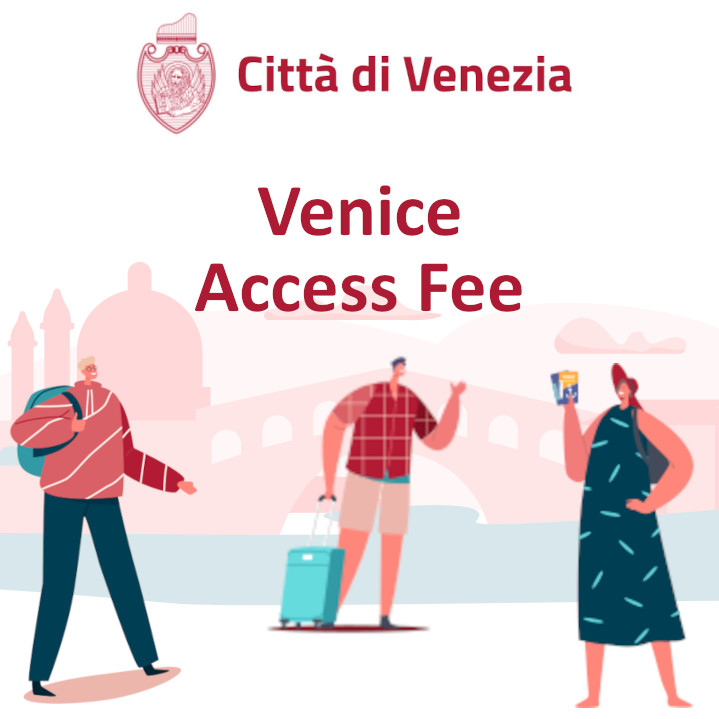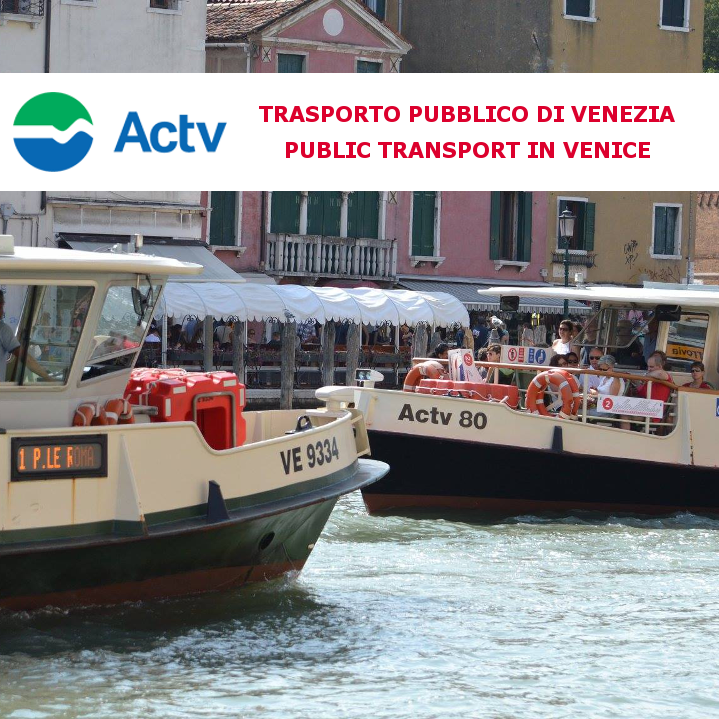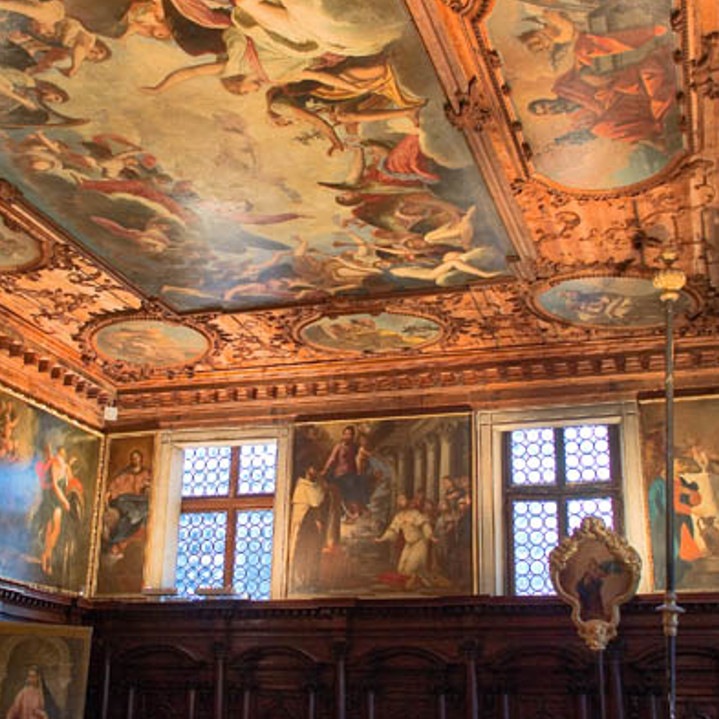You are here
Along the Grand Canal
ALONG THE GRAND CANAL
FROM PIAZZALE ROMA TO ST. MARK’S SQUARE
ST. MARK’S SQUARE
5th Itinerary
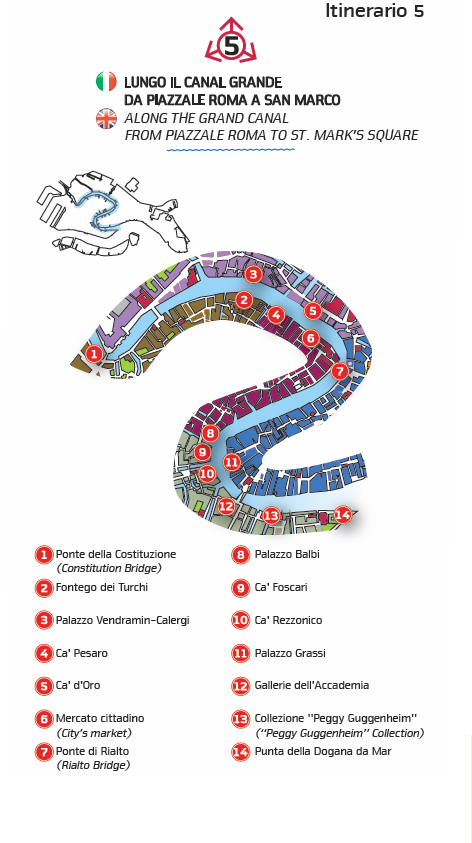 Whether you take route 2 (mainly for tourists) or route 1 (which halts at every stop), visiting Venice along its principal waterway is an original and unique way of getting to know the city. The water buses are, just like the gondolas, one of the most famous symbols of the city and its waterways. They are the symbol of a past modern age, but they still remain a wonderfully social, collective feature of Venice life. Visitors find them interesting and they give another wholly unique temporal dimension to the city, which is why we suggest you follow this itinerary, as it offers 40 minutes of not-to-be-missed glimpses into the fascinating history of Venice, a mix of past and present as you travel from one stop to the next. You can also get off the water bus and then get back on again (provided you continue to travel in the same direction and keep an eye on the time if yours is a one-way ticket). Of course, there is nothing stopping you from making this journey in the opposite direction, from Vallaresso (St. Mark’s to Piazzale Roma). Piazzale Roma is the starting point for both water bus routes 1 and 2 along the Grand Canal. Both routes go in the direction of Rialto-Vallaresso: at Piazzale Roma the landing places are separated, but as you look out towards the canal, go to the left-hand landing stage. As it leaves Piazzale Roma, the water bus passes beneath Constitution Bridge (Ponte della Costituzione), better known as the “fourth bridge across the Grand Canal”, designed by the famous Spanish architect Santiago Calatrava (and also known as “Calatrava’s Bridge”), built from stone, glass and steel, and opened in 2008 after a series of problems. As the water bus passes in front of the railway station, you have the Chiesa degli Scalzi on the left: this church, designed by the architect Longhena, is where the last Doge of Venice, Lodovico Manin, is buried, The water bus then passes beneath the Ponte degli Scalzi joining the Cannaregio and San Polo district of the city. This stone bridge, built in 1934, is a reconstruction of the bridge built by the Austrians. Shortly after leaving Riva de Biasio, on the same side of the canal you come to the Fontego dei Turchi (a nineteenth-century reconstruction) with its 12-13th century traditional Venetian- Byzantine façade, currently home to the Museum of Natural History. The next stop, on the other side of the canal, is San Marcuola. The church of the same name contains the young Tintoretto’s Last Supper. As soon as the water bus leaves the landing stage, it goes past Palazzo Vendramin-Calergi, one of the most important buildings along the Grand Canal, designed by Mauro Codussi. It represents the height of Renaissance architecture in Venice and the mezzanine floor was once home to the great composer Richard Wagner, who died here in 1883. Today it houses Venice’s municipal casino. As you look to the right, Campo San Stae opens up before you, a large square that takes its name from the church of San Stae built there in the 17th century. Just past the square you will see the striking outline of Ca’ Pesaro (entrance concession with Rolling Venice card) a masterpiece of 17th century Baroque architecture, the culmination of Baldassare Longhena’s creative genius: the building is now home to the Gallery of Modern Art and the Museum of Oriental Art. On the opposite side of the canal you can make out the shape of Palazzo Barbarigo, built during the second half of the 16th century, with its frescoed façade depicting allegorical scenes; one of the rare examples of a painted façade still left. On the same side of the canal the water bus passes in front of the splendid Ca’ d’Oro. Ca’ d’Oro is a masterpiece of flamboyant Gothic-Venetian architecture, previously featuring marble and gold decorations which are no longer present. The scenographic effect is still remarkable, however, thanks mainly to the highly effective night-time lighting. Ca d’Oro is open to the public. Just before you get to the main branch of the Grand Canal, you come to the Rialto area (waster bus stop: Rialto Mercato) and the city’s market, which today is a mixture of market stalls selling traditional products (mostly for tourists and more or less “traditional”). Unlike the Erbaria area of the city, where all the buildings date from the mid-16th century (the new factories were designed by Sansovino), Rialto was one of the first inhabited parts of the city, as shown by the significant historical evidence of this fact, and by the small church of San Giacomo (dating from the 5th century). The present layout however dates from the 16th century (following the devastating fire of 1514) and the reconstruction was entrusted to Antonio Abbondi, otherwise known as “Scarpagnino”. The fortunate position made it possible to develop the banks as areas for the unloading of goods, hence the names taken from the types of goods unloaded at each point along the canal (rive del Ferro, del Vin, del Carbon – the Iron, the Wine and the Coal wharves) and from the goods worked along the various rughe or alleys, such as that of goldsmiths (Ruga degli Orefici- the main thoroughfare). If you walk into the backstreets around the trade square (including the financial and trading district which was perhaps the then equivalent of the modern stock exchange, insurers and all!), and along the banks of the canals, you will come across a number of craft workshops, subdivided according to the respective corporations (type of business), adding to the goods offered by the market. Then, as now, the city’s open spaces near to the banks of the canals were where traders sold their vegetables, fruit, cheeses and meat, in places that are still called “Erbaria” (from the herbs sold there), “Naranzeria” (oranges), “Casaria” (dairy products), “Beccaria” (butcher’s), Pescheria (fish), etc. Palazzo dei Camerlenghi stands to the right of Rialto Bridge: this fine palazzo was built by Guglielmo dei Grigi between 1525 and 1528 and was originally used as the headquarters of Venice’s financial administration, with its own prison for the city’s debtors. As you pass under Rialto Bridge, the feeling that you are on a fantastic journey in time gets stronger (for those of you sitting comfortably by a window that is). Originally, Rialto Bridge, today one of the city’s most famous monuments, was a bridge made up of boats (known as the “quartarolo”) strung across the canal: the name “quartarolo” comes from the coin citizens had to pay to cross the bridge at that time. This bridge has for centuries been the focal point of entire network of thoroughfares connecting the area of St. Mark’s with that of Rialto, and as such it and its shops have become the logical extension of the city’s markets. With the help of a splendid 15th century painting by Vittore Carpaccio (in the Gallerie dell’Accademia), and with a little imagination, you can imagine the wooden bridge and the frenetic life of the market, as well as the many vicissitudes and reconstructions of the same bridge. It was built several times from wood (the first bridge dates from the 13th century) whereas today’s bridge, completed in 1591 by the architect Da Ponte, is a single-span structure covered by slabs of Istria stone. One curious point is that in order to build the bridge in 1551, a competition was held which attracted the most famous architects of that time, including Sansavino and Palladio, but the more adventurous, least practical projects were rejected. As you travel past the San Silvestro and Sant’Angelo stops and reach San Tomà, Palazzo Balbi rises up on the bend in the Canal. This fine building was built in the late 16th century and its considerable size and profuse decoration presage the arrival of Baroque architecture in Venice. It currently houses the offices of the Presidency of the Veneto Regional Council. To the left of the bend you can see Palazzo Contarini “Delle Figure”, an elegant Renaissance construction designed by Scarpagnino and named thus (“Delle Figure” – literally “of the Figures”) due to the two caryatid-like female figures positioned above the main door. The unusual large central window is shaped like a classical temple, complete with columns and tympanum. The Palazzo owes its fame to its bountiful library (many of the volumes are now part of the Biblioteca Marciana or National Library of St. Mark’s) and to the fact that it was once the home of Andrea Palladio. A little farther along on the opposite bank of the canal is Ca’ Foscari, set amid a series of elegant, sumptuous Gothic buildings. The beautifully restored Ca’ Foscari is a magnificent example of Gothic architecture from the second half of the 15th century and is famous for having had a series of very famous people among its guests, including Henry III, King of France, in 1574. It is now the head office of Ca’ Foscari University (housing the Chancellor’s office, the guest rooms, a number of departments of the Economics Faculty, and a delightful canteen). The next building is Ca’ Rezzonico (entrance concession with Rolling Venice card) a Baroque construction originally designed by Baldassare Longhena for the Bon family, and eventually completed in the 18th century for its new owners, the Rezzonico family (famous Milanese bankers), by the architect Giorgio Massari, who added the top floor and created a sumptuous ballroom, access to which is provided by a huge staircase. This building today hosts the Museum of the Eighteenth Century which, with its antique furniture and decorations, represents an insight into the lifestyle and culture of that time. In front of Ca’ Rezzonico you go past Palazzo Grassi (entrance concession with Rolling Venice card) designed by Giorgio Massari and built in the 18th century for the Grassi family from Bologna. This building, which for years has been owned by Fiat (since 1984), has held numerous exhibitions of ancient civilizations (the Pharaohs, the Etruscans, the Maya, the Greeks, the Celts and the Phoenicians) and of art (from German Expressionism to Flemish painting). Inside the building is a large courtyard with a monumental staircase leading to the upper floors. Together with the rooms in Punti della Dogana, Palazzo Grassi holds temporary and permanent exhibitions of the Contemporary Art collection belonging to the international fashion magnate and patron of various modern artists, François Pinault. These rooms and spaces have been recently redesigned in a rigorous style by the architect Tadao Ando. A short way on is the Ponte dell’Accademia, originally an iron bridge built in 1854 but more recently rebuilt in wood in 1932. This wooden structure was originally intended to be just temporary but became so popular among Venetians that it has been left as it was (in 2009 a competition was organised for its rebuilding, which once again found Venetians in disagreement as to what materials should be used!). At the foot of the bridge, to the left, stands the enormous religious complex of the former Convento della Carità, which now houses the Gallerie dell’Accademia: these galleries boast the best of Venetian art, with works by Bellini, Titian, Carpaccio and Tintoretto, as well as Giorgione’s celebrated The Tempest. On the opposite bank of the Accademia bridge stands Palazzo Cavalli Franchetti, the residence of Archduke Frederick of Austria in 1800 during the period when a garden was created on the site of a former boatyard. Many radical changes were made to the building in the late 19th century. Franchetti was a musician and art collector who donated Ca’ d’Oro to the city. The link with modern art
Whether you take route 2 (mainly for tourists) or route 1 (which halts at every stop), visiting Venice along its principal waterway is an original and unique way of getting to know the city. The water buses are, just like the gondolas, one of the most famous symbols of the city and its waterways. They are the symbol of a past modern age, but they still remain a wonderfully social, collective feature of Venice life. Visitors find them interesting and they give another wholly unique temporal dimension to the city, which is why we suggest you follow this itinerary, as it offers 40 minutes of not-to-be-missed glimpses into the fascinating history of Venice, a mix of past and present as you travel from one stop to the next. You can also get off the water bus and then get back on again (provided you continue to travel in the same direction and keep an eye on the time if yours is a one-way ticket). Of course, there is nothing stopping you from making this journey in the opposite direction, from Vallaresso (St. Mark’s to Piazzale Roma). Piazzale Roma is the starting point for both water bus routes 1 and 2 along the Grand Canal. Both routes go in the direction of Rialto-Vallaresso: at Piazzale Roma the landing places are separated, but as you look out towards the canal, go to the left-hand landing stage. As it leaves Piazzale Roma, the water bus passes beneath Constitution Bridge (Ponte della Costituzione), better known as the “fourth bridge across the Grand Canal”, designed by the famous Spanish architect Santiago Calatrava (and also known as “Calatrava’s Bridge”), built from stone, glass and steel, and opened in 2008 after a series of problems. As the water bus passes in front of the railway station, you have the Chiesa degli Scalzi on the left: this church, designed by the architect Longhena, is where the last Doge of Venice, Lodovico Manin, is buried, The water bus then passes beneath the Ponte degli Scalzi joining the Cannaregio and San Polo district of the city. This stone bridge, built in 1934, is a reconstruction of the bridge built by the Austrians. Shortly after leaving Riva de Biasio, on the same side of the canal you come to the Fontego dei Turchi (a nineteenth-century reconstruction) with its 12-13th century traditional Venetian- Byzantine façade, currently home to the Museum of Natural History. The next stop, on the other side of the canal, is San Marcuola. The church of the same name contains the young Tintoretto’s Last Supper. As soon as the water bus leaves the landing stage, it goes past Palazzo Vendramin-Calergi, one of the most important buildings along the Grand Canal, designed by Mauro Codussi. It represents the height of Renaissance architecture in Venice and the mezzanine floor was once home to the great composer Richard Wagner, who died here in 1883. Today it houses Venice’s municipal casino. As you look to the right, Campo San Stae opens up before you, a large square that takes its name from the church of San Stae built there in the 17th century. Just past the square you will see the striking outline of Ca’ Pesaro (entrance concession with Rolling Venice card) a masterpiece of 17th century Baroque architecture, the culmination of Baldassare Longhena’s creative genius: the building is now home to the Gallery of Modern Art and the Museum of Oriental Art. On the opposite side of the canal you can make out the shape of Palazzo Barbarigo, built during the second half of the 16th century, with its frescoed façade depicting allegorical scenes; one of the rare examples of a painted façade still left. On the same side of the canal the water bus passes in front of the splendid Ca’ d’Oro. Ca’ d’Oro is a masterpiece of flamboyant Gothic-Venetian architecture, previously featuring marble and gold decorations which are no longer present. The scenographic effect is still remarkable, however, thanks mainly to the highly effective night-time lighting. Ca d’Oro is open to the public. Just before you get to the main branch of the Grand Canal, you come to the Rialto area (waster bus stop: Rialto Mercato) and the city’s market, which today is a mixture of market stalls selling traditional products (mostly for tourists and more or less “traditional”). Unlike the Erbaria area of the city, where all the buildings date from the mid-16th century (the new factories were designed by Sansovino), Rialto was one of the first inhabited parts of the city, as shown by the significant historical evidence of this fact, and by the small church of San Giacomo (dating from the 5th century). The present layout however dates from the 16th century (following the devastating fire of 1514) and the reconstruction was entrusted to Antonio Abbondi, otherwise known as “Scarpagnino”. The fortunate position made it possible to develop the banks as areas for the unloading of goods, hence the names taken from the types of goods unloaded at each point along the canal (rive del Ferro, del Vin, del Carbon – the Iron, the Wine and the Coal wharves) and from the goods worked along the various rughe or alleys, such as that of goldsmiths (Ruga degli Orefici- the main thoroughfare). If you walk into the backstreets around the trade square (including the financial and trading district which was perhaps the then equivalent of the modern stock exchange, insurers and all!), and along the banks of the canals, you will come across a number of craft workshops, subdivided according to the respective corporations (type of business), adding to the goods offered by the market. Then, as now, the city’s open spaces near to the banks of the canals were where traders sold their vegetables, fruit, cheeses and meat, in places that are still called “Erbaria” (from the herbs sold there), “Naranzeria” (oranges), “Casaria” (dairy products), “Beccaria” (butcher’s), Pescheria (fish), etc. Palazzo dei Camerlenghi stands to the right of Rialto Bridge: this fine palazzo was built by Guglielmo dei Grigi between 1525 and 1528 and was originally used as the headquarters of Venice’s financial administration, with its own prison for the city’s debtors. As you pass under Rialto Bridge, the feeling that you are on a fantastic journey in time gets stronger (for those of you sitting comfortably by a window that is). Originally, Rialto Bridge, today one of the city’s most famous monuments, was a bridge made up of boats (known as the “quartarolo”) strung across the canal: the name “quartarolo” comes from the coin citizens had to pay to cross the bridge at that time. This bridge has for centuries been the focal point of entire network of thoroughfares connecting the area of St. Mark’s with that of Rialto, and as such it and its shops have become the logical extension of the city’s markets. With the help of a splendid 15th century painting by Vittore Carpaccio (in the Gallerie dell’Accademia), and with a little imagination, you can imagine the wooden bridge and the frenetic life of the market, as well as the many vicissitudes and reconstructions of the same bridge. It was built several times from wood (the first bridge dates from the 13th century) whereas today’s bridge, completed in 1591 by the architect Da Ponte, is a single-span structure covered by slabs of Istria stone. One curious point is that in order to build the bridge in 1551, a competition was held which attracted the most famous architects of that time, including Sansavino and Palladio, but the more adventurous, least practical projects were rejected. As you travel past the San Silvestro and Sant’Angelo stops and reach San Tomà, Palazzo Balbi rises up on the bend in the Canal. This fine building was built in the late 16th century and its considerable size and profuse decoration presage the arrival of Baroque architecture in Venice. It currently houses the offices of the Presidency of the Veneto Regional Council. To the left of the bend you can see Palazzo Contarini “Delle Figure”, an elegant Renaissance construction designed by Scarpagnino and named thus (“Delle Figure” – literally “of the Figures”) due to the two caryatid-like female figures positioned above the main door. The unusual large central window is shaped like a classical temple, complete with columns and tympanum. The Palazzo owes its fame to its bountiful library (many of the volumes are now part of the Biblioteca Marciana or National Library of St. Mark’s) and to the fact that it was once the home of Andrea Palladio. A little farther along on the opposite bank of the canal is Ca’ Foscari, set amid a series of elegant, sumptuous Gothic buildings. The beautifully restored Ca’ Foscari is a magnificent example of Gothic architecture from the second half of the 15th century and is famous for having had a series of very famous people among its guests, including Henry III, King of France, in 1574. It is now the head office of Ca’ Foscari University (housing the Chancellor’s office, the guest rooms, a number of departments of the Economics Faculty, and a delightful canteen). The next building is Ca’ Rezzonico (entrance concession with Rolling Venice card) a Baroque construction originally designed by Baldassare Longhena for the Bon family, and eventually completed in the 18th century for its new owners, the Rezzonico family (famous Milanese bankers), by the architect Giorgio Massari, who added the top floor and created a sumptuous ballroom, access to which is provided by a huge staircase. This building today hosts the Museum of the Eighteenth Century which, with its antique furniture and decorations, represents an insight into the lifestyle and culture of that time. In front of Ca’ Rezzonico you go past Palazzo Grassi (entrance concession with Rolling Venice card) designed by Giorgio Massari and built in the 18th century for the Grassi family from Bologna. This building, which for years has been owned by Fiat (since 1984), has held numerous exhibitions of ancient civilizations (the Pharaohs, the Etruscans, the Maya, the Greeks, the Celts and the Phoenicians) and of art (from German Expressionism to Flemish painting). Inside the building is a large courtyard with a monumental staircase leading to the upper floors. Together with the rooms in Punti della Dogana, Palazzo Grassi holds temporary and permanent exhibitions of the Contemporary Art collection belonging to the international fashion magnate and patron of various modern artists, François Pinault. These rooms and spaces have been recently redesigned in a rigorous style by the architect Tadao Ando. A short way on is the Ponte dell’Accademia, originally an iron bridge built in 1854 but more recently rebuilt in wood in 1932. This wooden structure was originally intended to be just temporary but became so popular among Venetians that it has been left as it was (in 2009 a competition was organised for its rebuilding, which once again found Venetians in disagreement as to what materials should be used!). At the foot of the bridge, to the left, stands the enormous religious complex of the former Convento della Carità, which now houses the Gallerie dell’Accademia: these galleries boast the best of Venetian art, with works by Bellini, Titian, Carpaccio and Tintoretto, as well as Giorgione’s celebrated The Tempest. On the opposite bank of the Accademia bridge stands Palazzo Cavalli Franchetti, the residence of Archduke Frederick of Austria in 1800 during the period when a garden was created on the site of a former boatyard. Many radical changes were made to the building in the late 19th century. Franchetti was a musician and art collector who donated Ca’ d’Oro to the city. The link with modern art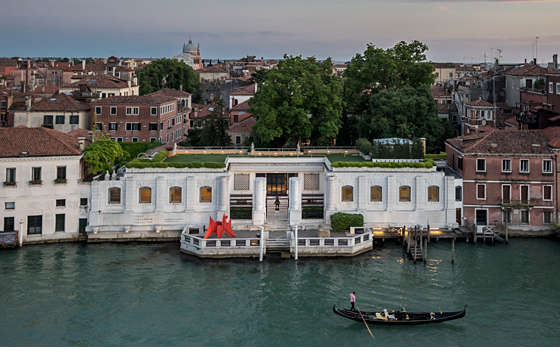 , characterised by the presence of foreign rulers in the city, continues as we get to Palazzo Venier dei Leoni, a building of an unusual (low) height, left unfinished and currently home to the “Peggy Guggenheim” collection (entrance concession with Rolling Venice card) its terrace overlooking the canal boasts the striking and beautiful Cavalier, by Marino Marini. Just past this we reach Ca’ Dario, one of the most famous Renaissance buildings along Venice’s Grand Canal, a wealth of ornaments and decorations, tilting slightly due to past subsidence and the sadly renowned for the string of mysterious disastrous events affecting many of its former owners. The Madonna del Giglio stop (left, get off here to visit the Grand Theatre La Fenice) and that of La Salute (right), are the last on the Grand Canal. To the right stands the imposing and beautiful Basilica della Madonna della Salute, a masterpiece designed by Longhena as an ex voto after the end of the plague in 1630. Each year, Venetians celebrate this event on 21 November in the form of a very popular religious festival. On the tip of Dorsoduro (right) is the Punta della Dogana da Mar (entrance concession with Rolling Venice card) an old customs landing stage for goods from the 16th century onwards, with its robust tower with two bronze Atlases hold up the golden Globe on which the statue of Fortune turns, representing the ancient entrance to the city of Venice. Since 2009 this space has been managed by the Pinault Foundation, which has paid for restoration work (and once again, the skilful hand of the architect Tadao Ando is apparent here), and for the installations, thus guaranteeing the reopening of spaces that would have otherwise been left abandoned and derelict. The water bus finally reaches Vallaresso (left) and our journey along the Grand Canal is ended. This is the perfect place to stop and visit the Marciana district. As you walk down Calle Vallaresso and turn right, you come to the rear of Palazzo Correr (the Napoleonic wing) and this leads into St. Mark’s Square right in front of the Basilica.
, characterised by the presence of foreign rulers in the city, continues as we get to Palazzo Venier dei Leoni, a building of an unusual (low) height, left unfinished and currently home to the “Peggy Guggenheim” collection (entrance concession with Rolling Venice card) its terrace overlooking the canal boasts the striking and beautiful Cavalier, by Marino Marini. Just past this we reach Ca’ Dario, one of the most famous Renaissance buildings along Venice’s Grand Canal, a wealth of ornaments and decorations, tilting slightly due to past subsidence and the sadly renowned for the string of mysterious disastrous events affecting many of its former owners. The Madonna del Giglio stop (left, get off here to visit the Grand Theatre La Fenice) and that of La Salute (right), are the last on the Grand Canal. To the right stands the imposing and beautiful Basilica della Madonna della Salute, a masterpiece designed by Longhena as an ex voto after the end of the plague in 1630. Each year, Venetians celebrate this event on 21 November in the form of a very popular religious festival. On the tip of Dorsoduro (right) is the Punta della Dogana da Mar (entrance concession with Rolling Venice card) an old customs landing stage for goods from the 16th century onwards, with its robust tower with two bronze Atlases hold up the golden Globe on which the statue of Fortune turns, representing the ancient entrance to the city of Venice. Since 2009 this space has been managed by the Pinault Foundation, which has paid for restoration work (and once again, the skilful hand of the architect Tadao Ando is apparent here), and for the installations, thus guaranteeing the reopening of spaces that would have otherwise been left abandoned and derelict. The water bus finally reaches Vallaresso (left) and our journey along the Grand Canal is ended. This is the perfect place to stop and visit the Marciana district. As you walk down Calle Vallaresso and turn right, you come to the rear of Palazzo Correr (the Napoleonic wing) and this leads into St. Mark’s Square right in front of the Basilica.



